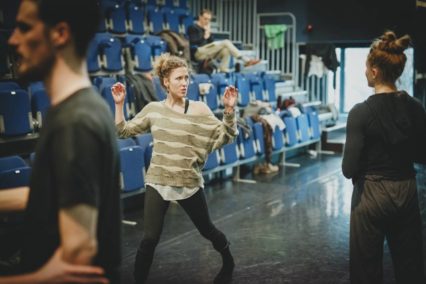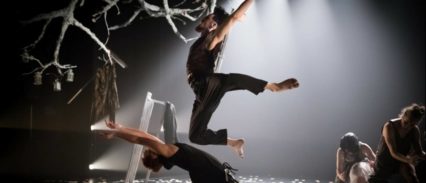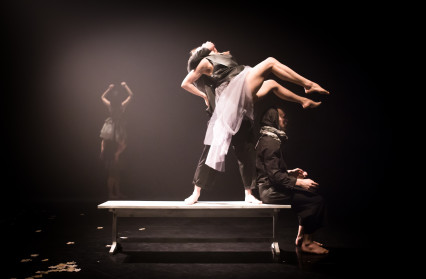Jane Oriel casts a critical eye over Folk, a National Dance Company Wales production at Sherman Cymru created by Caroline Finn.
Entering a fresh era for the company, Folk is the first production created by NDCW’s new Artistic Director, Caroline Finn. Exploring social dynamics, and for Finn, those of her new corps of dancers, interplay and response, cooperation and individuality are the key concepts employed for people-watching leading to the old phrase “there’s nowt so queer as folk”.

The lower trunk and roots of a large tree hang on the stage left with the branches part of it left imagined, way up out of sight.
The group of nine are dressed in shabby shades of grey, pink and green with much dirty tutu net in evidence. On the bench to stage right they all pose in tableau, then re-pose in increasingly more narcissistic, adventurous shapes as though being photographed. From here, scintillating motifs performed by one or more dancers at a time, maintain a constant fluidity, full of turns and rich flexibility that act like a baton being passed to each successive chapter. Although reason for the scene to be set beneath ground was not entirely clear, signposted by the visible tree roots, some scenes warmly suggested an unmade Peter Greenaway film about the Underworld.
At one part, a single female dancer responds to a soundtrack of squeals and guttural intakes of breath. Working through a repeated sequence where her body falls forward, then snaps to standing to grasp one breast, a reference to De Keersmaeker’s famed 1980s dance, Rosas danst Rosas.
Of the two other dances in the programme, both are part of international repertoire by established Swedish choreographers. John Inger’s seemingly carefree “Walking Mad” is a high-spirited, fast-paced romp that’s the embodiment of the heels-kicking excitement of keeping a brilliant secret. The backdrop is a long, adaptable wooden fence that keeps its own secrets until the odd concealed door or two open, just like they did for Top Cat, the ‘60s TV cartoon. The dancers can make the fence fold or fall, full of pretend peril á la Buster Keaton. Unspoken graphic humour features throughout “Walking Mad”. There’s a lot of tearing about where a group of dancers pursue one figure, arms outstretched as they go (Scooby Do,anyone?).
Played out to the dignified pomposity of Ravel’s well known Bolero, the dancers express a freedom of movement that has more in common with a children’s party than balletic law. The contemporary shapes and rhythms, be they uncontrollable wriggles, shakes or stompings, seem to be interpretations of whatever happens to drift through the dancers’ minds at that instant. Eventually, exuberance takes on hints of something more malevolent with playful captures looking more like attempted detentions, so attitudes warp and tempers fray. When the Bolero comes to its crashing finish, we learn that the dance has not and a petulant, aching duet unfolds to “Für Aline” by Arvo Pärt where cooperation cannot be relied on. Is this what has really been going on under the surface? Could the fun and games and the individualistic working things through really have been a front, so as not to have to contemplate a dysfunctional relationship? Party every night so we don’t have to talk? Exquisite.
Rhythm underpins everything in Alexander Ekman’s “Tuplet” and its several episodes explore the subject in a variety of ways.

While the auditorium lights still shine, we watch a pair of projectors being set up to show moving images on the back stage scrim. A series of close-up talking mouths and on the other, hands expressing, gesticulating get the conversation going as one by one, dancers enter the stage scatting to themselves and creating individual sound and movement identities to internalised beats and an eventual group cacophony.
The conversation expands…
“If an external pattern clicks with the internal pattern of a listener, there’s a sense of harmony there, or happiness if you will,” says one man to another in the soundscape.
This discussion about the nature of rhythmic connection is explored, ending with a gentlemanly handshake at the narrative’s end. Theory is then put in to practice as six white vinyl mats are laid at spaced intervals along the front of stage. As individual performance podiums, an odd-man-out game brings fun, skill and surprise as lights go off, then on again to reveal the dancers in fresh harmonising forms, except for one or maybe two people, different each time. Fast-paced and enormous fun, as the power of the beats reach each of us and we wait the surprise of seeing what happens next, there’s a tug to join the game ourselves.
Taking play to a new humorous complexity, the rhythmic identities of names are played with. The recorded voice calls out each character’s two names in turn, with the dancer in question expressing their own syllable patterns in an individual way. Then things start to get get jiggly as when a DJ might wheel back vinyl, making the names stutter, repeat and drag, so calling on the owner of each to perform their cypher perhaps, exhaustingly numerous times or be caught out. The music and spoken voices employed in Tuplet give the whole piece a suggestion of the Beat Generation, which is perfectly apt in such an entertaining and snappy piece of work.
The weightless skills from all performers and the character acting required at points tonight says great things about the body of talent accessible by Wales’ national dance company. As beautifully executed and graciously designed as Folk undoubtedly is, and not wanting to denigrate it in any way, it suffers a little by being placed side by side with a pair of favourites that have been performed around the world by various companies for ten or more years. Nonetheless, all three dances are hugely satisfying and thoroughly absorbing.
To find out more about National Dance Company Wales visit their website.
Jane Oriel is a regular contributor to Wales Arts Review.












